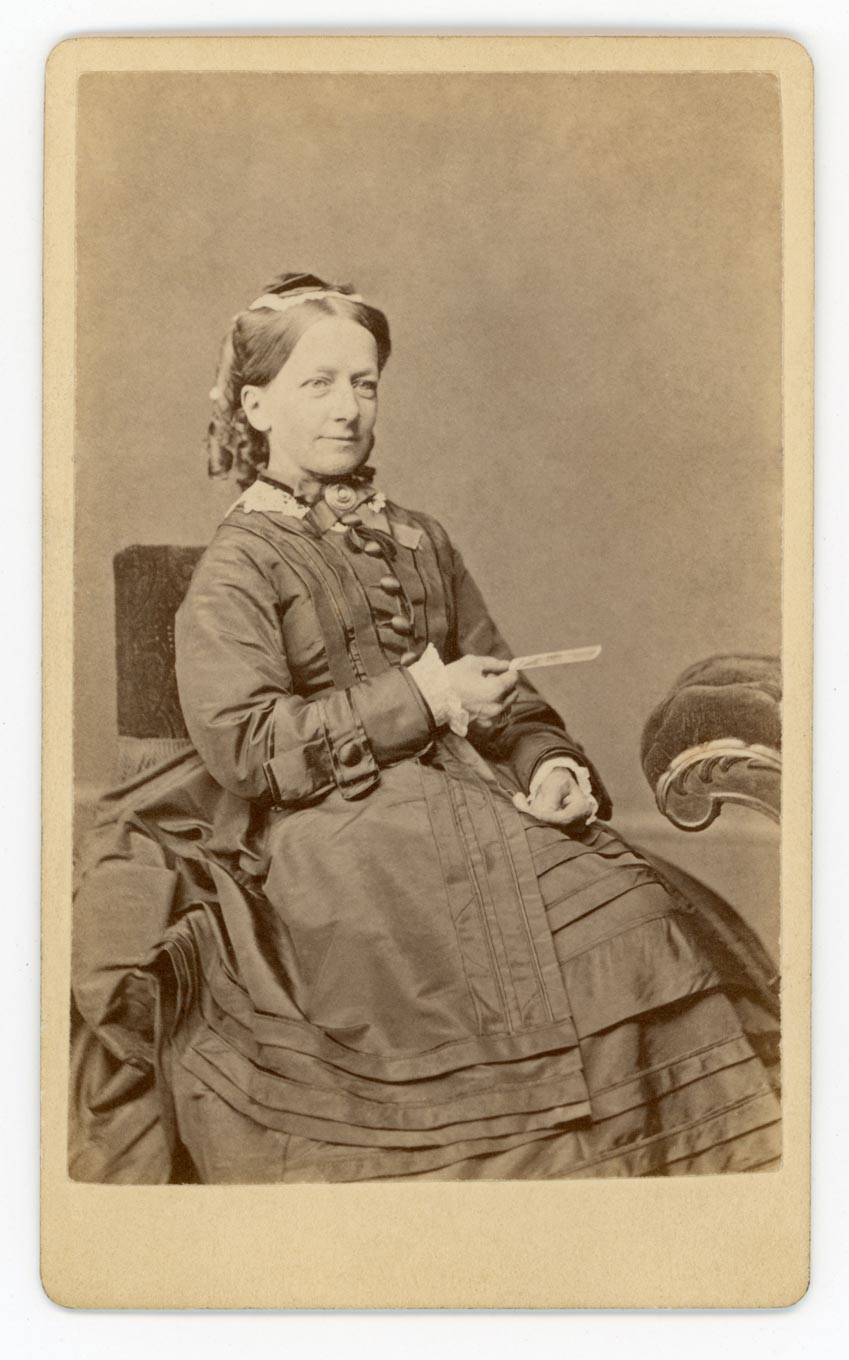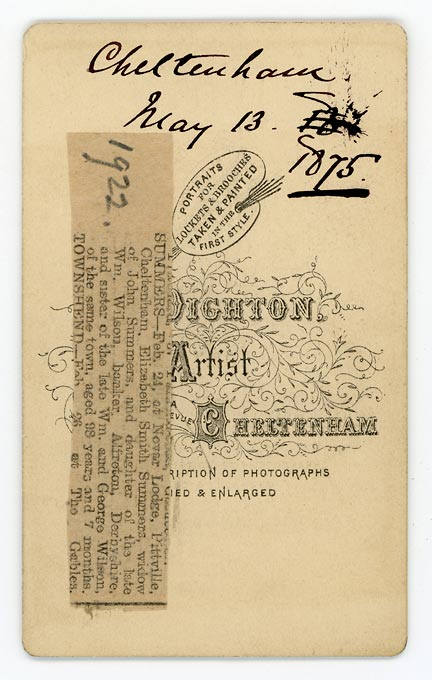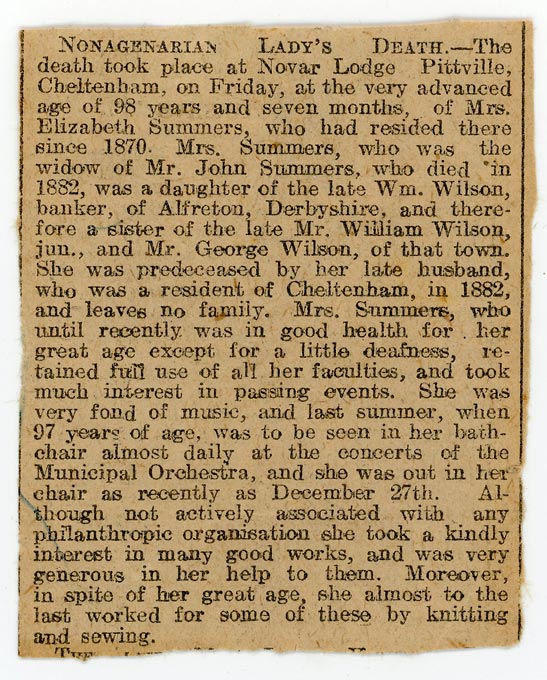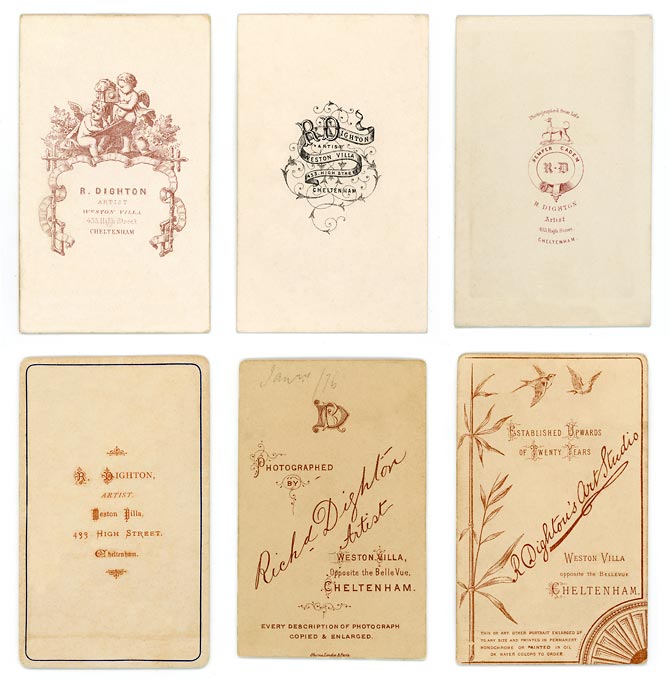In Mexico it is believed that a person does not really die until their name is spoken for the last time. I must say I like the idea since it seems to give some purpose to the articles I write. As a photo historian I love digging the past and finding out information not only about the photographers and their work, but also about the sitters whose likeness they took. This is what decided me to write this column, to drag these little-known people from oblivion and give them, so to speak, a second lease of life. They may not have made history or become famous but they lived on this earth at some point, loved and were loved, laughed, cried, had fun, suffered, took photographs, or sat for them. This, in my opinion, is enough to make them worth being remembered.
PART TWO
Mrs Summers (sitter) and Dighton (photographer)
On May the thirteenth 1875, Mrs Elizabeth Summers pushed the door of Richard Dighton’s photographic studio, at 433 High Street, Cheltenham, Gloucestershire, and had some carte-de-visite portraits taken. After she collected the photographs or they were delivered to her house, she wrote down the date of the sitting on the back of one of the mounts. As she was writing the year her quill caught the fibres of the paper and spluttered ink so that she had to cross the date out and write it again underneath. When she had done so, she underlined it and this is how we know the exact day she had her likeness taken. Years later, when she died, someone cut out her death notice on page 2 of the March the fourth 1922 issue of the Cheltenham Chronicle, pasted it on the back of the image and wrote the date 1922 in pencil on the clipping. This unknown person, probably a relative, also cut out a longer piece about Mrs Summers from page 8 of the same newspaper and as it was too big to paste on the back of the card, kept it next to it. When I bought the card on eBay, some time in February 2021, the loose clipping was sent to me with it and this is how I got interested in the sitter and the photographer who had captured her image some one hundred and fortysix years ago. I must say that apart from the kind-looking expression of the lady in the photograph, the half-smile on her face and the fact she is holding a carte-de-visite in her right hand, the date and the mention of her name were good incentives to make me purchase that image.


Elizabeth Summers was born Elizabeth Smith Wilson at Alfreton, Derbyshire, in the first half of 1823. Her exact date of birth remains unclear but we know she was baptised on July 28th 1823. Her father William Wilson, a draper, and his wife Ann Dorothy, née Barwick, had been married since 13 September 1819. Soon there were at least two other children, boys, and from what I have found out, Elizabeth was the only daughter they had. When the 1841 census took place the boys were away at school somewhere and Elizabeth, now aged seventeen, was the only child at home with her parents. The family was still living at Alfreton, along with three servants, one of whom, named Elizabeth Fox, would stay with them for another twenty years. On 9 May 1849 Mrs Wilson died and Elizabeth was left to look after her father. The 1851 census reveals that one of Elizabeth’s brothers, Joseph George, now seventeen, was a solicitor’s articled clerk, that Elizabeth was still a spinster and that the Wilsons still kept three servants. Mr Wilson was then listed as a landed proprietor. Ten years later, however, he was described as a banker while his unmarried son Joseph had now become an attorney-at-law. Elizabeth remained unmarried but there was a new addition to the family, Mr. Wilson’s four-year-old grand-daughter Catherine. Less than six months after the census took place, Mr. Wilson senior passed away on 21 September 1861 and was buried five days later. Just over six years after her father’s death, Elizabeth, now aged forty-four, married one John Summers, a Sixty Nine year-old retired Madras merchant who, although born in London, was now living at Cheltenham, Gloucester, where the married couple spent the rest of their lives. At the time of the 1871 census Elizabeth and her husband were with friends in Herefordshire so that we have no information as to what their household consisted of. When Mrs Summers visited the studio of Richard Dighton, she was about fifty-two years of age, had been married for nearly eight years but had no children. The 1881 census shows that Mr and Mrs Summers were living at Novar Lodge, Cheltenham, where they had moved some time in 1870. They had two servants, a cook and a housemaid, and when the enumerator knocked on their door on April the third, they also had two visitors staying with them. John Summers passed away on 19 August 1882 at the age of eighty-five. Elizabeth Summers stayed at Novar Lodge where we find her with her niece, Catherine Wilson, in the 1901 census. Catherine is listed a Lady’s companion. At the time of the 1911 census Elizabeth, now eighty-seven, was staying as a boarder at the lodging house of one Mrs Amelia Harris at Clevedon, Somerset. She was still living at Novar Lodge though and this is where she passed away on February the twenty-fourth 1922, aged 98 years and seven months. She was buried on March first, three days before the paper clippings I mentioned at the beginning of this piece were published in the Cheltenham Chronicle. The shorter one, pasted on the back of the carte-de-visite, reads thus:
SUMMERS – Feb. 24, at Novar Lodge, Pittville, Cheltenham. Elizabeth Smith Summers, widow of John Summers, and daughter of the late Wm. Wilson, banker, Alfreton, Derbyshire, and sister of the late Wm. And George Wilson, of the same town, aged 98 years and 7 months.
As for the second one, here it is as it appeared on page 8:

And what about the photographer who captured the features of Elizabeth Smith Summers and fixed them for us to see after all those years? Richard Dighton was born at Pimlico, London, on 25 August 1822, the eldest child of Richard Dighton (1795-1880), an artist mostly remembered for his caricatures of Regency celebrities, and of his wife Mary Davis (1797-1871). Richard Junior was baptised at Saint Luke’s, Chelsea, nearly two years after his birth, on 12 May 1824, and was not an only child for long as sibling after sibling was born: Mary, Martha, Rachel, Joshua, Sarah, Elizabeth, John and Ruth. In 1828 Richard Dighton the elder took his growing family west and settled in Worcester then in Cheltenham for the following twenty years of his life. As Richard junior grew up, he followed into the footsteps of his father, of his grandfather Robert Dighton, of his grandfather’s brother, Denis Dighton, and of his uncle, Robert Dighton Junior, becoming an artist too, as did his younger brother Joshua. On February 21st 1846, Richard Dighton Junior, who was then living at Liverpool, married Elizabeth Walkinshaw Radford, the daughter of engraver Jonas Radford, at Saint Mary’s Church, Cheltenham. They had six children, two of whom were born at Knightsbridge, London, two at Birkenhead, Lancashire, and two at Cheltenham, Gloucestershire. Elizabeth Dighton died suddenly on May 7th 1860, leaving her husband to look after their six children. The 1861 census lists Richard Dighton as an Artist and Photographic Colourist, living at 2, St. Phillips Gardens, Cheltenham, with his family, a House Servant and a Thirty Three-year old housekeeper named Ellen Maunder. The latter must have proved a great help and an even greater companion as, on 15 January 1862, she became the second Mrs Richard Dighton. Five more children were born of this union between 1863 and 1873. The 1871 census reveals that Richard Dighton had now become a full-time photographer with his home and studio at Weston Villa, 433 High Street, Cheltenham, which is where Mrs Summers had her portrait taken four years later. At some point in his photographic career Richard Dighton added the words “Semper Eadem” on the back of his carte-de-visite portraits. That motto, which was the one adopted by Ann Boleyn, and later by her daughter Queen Elizabeth, can be translated as “Ever the same” or “Always the same”. It is not clear what it refers to but certainly not to the backs of Mr Dighton’s photographs which, as you can see for yourself in the illustrations below, changed regularly over the years.

We know from the 1881 census that Richard Dighton was still operating from the same address. The Fifty Eight year-old photographer was living there with his wife, six of his eleven children, a twenty-four year old assistant named Frederick Jones, his wife’s niece and a servant. By the time of the next census, on 5 April 1891, Richard Dighton had been dead for a few weeks. He passed away on March 11th 1891 and was buried five days later. His wife survived him by over seventeen years and died on December 16th 1908. However, the photographic studio did not disappear after Richard Dighton’s death and in the early 1900s it was run by one Ernest E. White before becoming Whaley’s studio a few years later. I am sorry to say that the few cartes-de-visite I have seen from that later studio are terribly faded and far from impressive.
Images courtey of Denis Pellerin.

